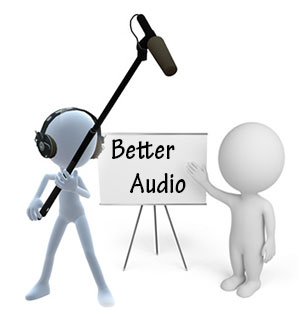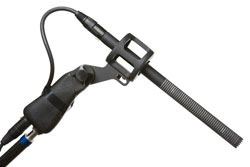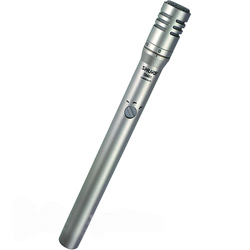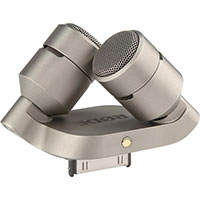 It’s odd, but sound for video is often given little, if any, thought.
It’s odd, but sound for video is often given little, if any, thought.
There are a lot of great-looking videos out there all over the web. Sadly, as many as half of these videos may look great, but they sound terrible.
Let’s talk about one particular kind of video – the talking-head video, meaning videos where someone is talking on-screen. Typically this is a person talking directly to the camera with usually only their head and shoulders being visible. That’s where the moniker “talking head” comes from. But any video where people are talking on-screen suffer the same problem and of course, have the same solution.
The primary cause of poor audio on talking-head videos is that there is too much distance between the speaker and the microphone. Combine that with the fact that a lot of web video is shot with camcorders, or even mobile devices now, using only the built-in mics, which are usually not designed for great audio. If you toss in a common 3rd element to most videos, the fact that the recording room or other space is not acoustically ideal, then you have a recipe for poor video sound.
Better sound for video: The solution for two of the root-causes
If you can somehow close the distance between your mouth and the microphone, you can hugely improve or even eliminate two of the problems I mentioned: the far-away sound and the poor acoustics sound. The reason for the latter is that the closer a mic is to your mouth (in most cases), the less of the ambient sound the microphone picks up. This makes the voice sound more immediate and clear. So the solution is to get the mic close to your mouth. Within a foot or two is optimal.
If your video camera has an external microphone input jack, you can plug a microphone into that. Many folks use lapel mics that clip to their clothing, putting it very close to the mouth. Another way to do this is to hold the mic close to your lips, as you’ve seen many a TV news reporter do.

If you don’t want a microphone in your shot, you can do like they do in the movies. That is to put a microphone on a boom stand, or held by and audio guy with a boom pole, just a couple of feet over and away from the speaker’s face, just out-of-frame.
What kind of mic should I use for this?
Movies and TV shows typically use a specific kind of mic for this, called a shotgun mic. I did a review on a popular shotgun mic called the Sennheiser MKH 416, which you can see (and hear) here: Sennheiser MKH 416 Shotgun Microphone Review.
A popular alternative to shotgun mics, especially when shooting indoor video, is a small-diaphragm condenser mic (for a review of what that means, see our article What Are The Different Types of Microphones?). Sometimes these mics are called “pencil” microphones. For indoor shoots, pencil mics are usually less sensitive to room echo than shotguns.
So getting a decent microphone close to your mouth is the single best thing you can do to improve sound for video. But what if you don’t have an external mic jack on your video camera? Most camcorders don’t have seem to have them, if my shopping experience is anything to go by. Well if your camera cannot accept a microphone, you still have options. In fact your best option is to once again look to the folks making the TV shows and movies. Record the audio completely independent of the video.

So how do I record the audio separately?
If you have a computer in the room you’re using to record the video, you can use that, along with an audio recording interface. The one I used in the video below is the Focusrite Scarlett 2i2. I just plugged my pencil mic (Shure SM81) into the interface, which plugs into my computer via USB, and put the mic on a boom stand just out of frame.
The pencil-mic-into-an-audio-recording-interface combo can cost a few hundred dollars at least. So if you’re on a tight budget, you can actually use a USB mic in the same way! You can hear the result in the video below. I used a $49 USB mic called the Samson Q2U.
How do I sync the separate audio to the video?
In either case, what you do next is open your video in your video editing program (I used Vegas Pro in the video below), import the audio into it, sync it up with the camcorder audio (which will record its awful through the built-in mics on the camera) by putting it into a new audio track below the camcorder audio track. Then once the audio files are in sync (you can manually do this just by sliding the good audio around under the camcorder audio until they match up), simply delete or mute the camcorder audio, and voila! You have the good video with the good audio.

If you can’t get at least a laptop to where the video shoot is happening, you can use a mobile digital recording device like a Zoom H4, or any of a dozen other similar brands and models. These record high quality audio, usually onto SD cards, which you can then import into your video program. Of course you can get mics nowadays that plug straight into your smart phone. Some really good examples of these are the Apogee MiC or the Rode iXY. Rode even makes a lapel mic now that plugs into an iPhone or iPad – the Rode SmartLav.
In the video below, you can see and hear exactly what I’m talking about.
http://homebrewaudio.wistia.com/medias/umogpgxapc?embedType=async&videoWidth=700
If you have any tips on getting better sound for video, please leave a comment!
Cheers,
Ken
Thanks Ken for your excellent presentation on video audio. Awesome tips indeed!
You’re welcome Roger! My pleasure. Glad you found it useful.
Cheers!
Ken
Jeez, Ken, I wished I’d found this post earlier ….before I bought a desktop mic from Amazon. I thought your use of the different mics was very illustrative.
One question, when you were talking about the the Apogee MiC, the Tascam iM2X, or Rode iXY, to they also work on Android phones?
Henk,
Thanks! about the mobile mics, they are all are iOS only at the moment. But one that you CAN now use with Android is the IK Multimedia iRig MIC. That’s an aff link BTW;). They just recently added Android support.
Hope that helps!
Ken
I have a commercial real estate brokerage I own. I am going to start uploading videos on a you tube channel embedded on my websites.
For my office what would be the best lighting and audio set up that would be total around under 500 and easy to use. My videos will be about 2 minutes and I will do one a day on various commercial real estate topics. I have windows 8 computer and quad processor (only 6 months old) and creative lab speakers. I have a Audio Technica ATR 30 I bought a few years back that is Cardiod and plugs into the computer that is a dynamic microphone. I probably bought the wrong thing as I am clueless on this stuff. Best interior lighting and shotgun mic with upload and go capability?? Any help appreciated. I am in Georgia in the u.s. if that matters.
Joel, for the lighting you should check out this video – http://wistia.com/learning/down-dirty-lighting-kit. It’s perfect for videos like you’re talking about. And for the sound, well the video on this page basically gives you options for great talking-head audio at multiple price-points, starting at about $49 for a USB mic. You could use your ATR30 for this too, though you’d need an audio interface (also covered in the video) to record it. The key is getting the mic close to the speaker’s mouth – as close as you can, though a foot or two above the frame of the video usually works great. Also, it’s probably best to record the audio separately from the video since most video cameras don’t have external mic inputs. And even if they do, they usually are pretty noisy. So record the audio onto your computer or a mobile device. Then import it into your video program, sync it up with the crappy audio captured by your camera, then delete that camera audio track, leaving you with the good audio.
Hope that helps!
Ken
Thanks Ken for your help. One thing I am still confused about. Right now I have a newer quad core processor computer.
For video I do not have a camera. I have a Logitech 720p webcam that plugs into one of my usb’s on my computer.
If I buy a shotgun mic can’t that mic just plug in to my computer via usb. I am not an audio/video tech. The Logitech webcam has a button the uploads right to youtube. I am trying to just record a brief 2 minute video daily and if the shotgun mic plugs in can’t that mic just take over instead of the webcam one?? Then I just record video and upload it?? I am trying to eliminate steps where I will screw something up. I wish there were local audio/ video people that could help with stuff but there is just music stores and they do not really know anything.
Hi Joel. That’s an awesome question. Your webcam is set up to make it fast and easy to upload videos straight to YouTube. But having to edit the video first sort of negates the efficiency of that. However, you may still be able to improve the audio greatly without having to do all that editing, which is really more applicable for videos shot with separate video cameras.
I don’t have that particular webcam, so I don’t know exactly how it works. But if it’s like most, it will take its audio from whatever audio device you have set up as the default in your operating system. If that is so, all you’d need to do is like you said – get a good microphone set up on your computer.
You could start out using the mic I used at the end of the video – a USB mic (that does simply plug into a USB port on your computer) like the Samson Q1U. It only costs $49. But if you wanted to use a higher quality mic – either a shotgun, or a pencil mic (small-diaphragm condenser mic) like in the video above, you won’t be able to plug those into a USB port directly. You’ll need an interface of some sort that plugs into the USB port. Then you plug the mic into that. I showed one interface in the video – the Focusrite Scarlett 2i2. But there are tons out there. I did find a USB shotgun mic on the web here: http://www.proofpronto.com/usb-shotgun-microphone.html but I can’t speak to its quality.
I hope that helps!
Ken
Just purchased the Rode SmartLav… the sound seems pretty good on the review videos.. thanks for the suggestion you saved me a few hundred bucks!
You’re welcome Michael. Glad I could help!
Cheers,
Ken
Hi Ken, I have a sennheiser mke600 shotgun mic plugged into my canon 70d, but the audio still sound “tinney” – any ideas as to why this might be happening?
Andrew,
You say it sounds “tinney?” So the audio quality is the issue and not hissing or other noise? The latter is usually the problem, in my opinion. But one great way to test this would be to record the mic into something other than the camera. You can either get an XLR-to-USB adapter/interface like a Blue Icicle, or a standard recording interface unit like a Focusrite 2i2, and record into Audacity or Reaper (or any recording software). If it still sounds bad, then it is probably be the mic. But I suspect that it’s the camera. I know this one is supposed to be for DSLRs, but cameras are definitely optimized for video/pictures and not audio.
Hi Ken,
Thanks for the tip on recording separately and syncing. However I noticed in your video there were brief micro second moments of video interruption sometimes termed “video stuttering” that puts the audio and video out of sync. I use Vegas also as my video editing program and some uses who were experiencing this problem were able to eliminate it by turning off the video preview in Vegas while rendering.
I don’t know if that was the reason for what I am seeing or it is being caused by something else, but I thought this might help.
I’m going to try doing a recording two ways for http://www.preciousmetalsinvesting.com and see which works out best and let you know. I’m going to use the Rode NTG-2 shotgun mic using the battery power and an adapter which will let it plug into the camcorders 1/8″ external mic jack. Then I will also try it with the same mic in the same position using the XLR output into an interface with XLR inputs that is plugged into the computer. I’ll record it as you suggested and then sync in Vegas. I’ll let you know what I find out.
All the best,
Ted
Ted,
What you’re seeing is not stuttering. I was still learning to do transitions between video clips (left over after slicing out mistakes or simply joining different takes). Some of the transitions were done with transition effects where it looks like there is a page flipping or flying away. But I sped them up a little too much; Looking at it just now, I realize I should have left them at their default speed because they’re a little too fast and rather than create a smooth transition, they may actually be a bit like “whoa, what was that?” In my latest videos (the tip series) I am a lot further down the learning curve and the transitions are much smoother. I also noticed that I didn’t use transition FX on a bunch of the cuts, so they jump a bit (“jump cuts”). I don’t leave jump cuts in any longer unless they are barely noticeable. What you said about using a much lower resolution on the preview window is true. I use “Draft” so that the video does not lag, as it does even on a pretty powerful computer. But yes, if you weren’t aware of the lag caused by editing while using “Best” preview quality, it is possible for someone to get the audio and video out of sync. That never happened in my video. If you think you see a place that was NOT a transition/cut where the audio is out of sync with the video, can you tell me where in the video by time-stamp? Good luck on your experiment. Remember to get the mic as close to your mouth as possible – maybe just 2-3 feet above your head and just out of frame.
Hi. This page comes very close to answering my question, which is fairly simple, but pretty specific. I want to record live video and audio together–pretty much a one-shot performance video–using a webcam for the video, but instead of the built-in mic on the cam, record the audio through my Focusrite Scarlett 2i2. I was able to do this easily with the webcam that is built into my computer, but unfortunately the cam stopped working. Now I’m considering getting an add-on webcam, but I don’t know if I can still make the audio record through my Scarlett.
Do you know anything about this?
Thanks,
Bob
Hi Bob. I don’t see why not. I use a 3rd-party webcam on my desktop computer to record Skype converstaions or Google Hangouts On Air interviews using my 2i2 for audio. Not sure what audio recording program you’re using, but just make sure you choose the 2i2 as your audio device in there. Then simply start the audio recording before you start the video recording and you should be good to go. Does that help?
Ken
Thanks for this article and for your blog in general. Good info keeps simple things simple like they should be. I have a related question: I make music with a live looping setup and was able to capture one live performance video using my built-in webcam and simply substitute the audio input by running mics through a Scarlett 2i2 directly into my computer…and then the built-in webcam stopped working. No amount of replacing drivers has fixed the built-in cam (a Suyin Optical Acer Crystal Eye Webcam). I can’t figure out how to make my process simple again. Most add-on webcams don’t have a separate USB audio input (as far as I can tell) Any suggestions?
Oops, sorry. I asked you about this before. Can’t believe I’ve been stuck on this for over a year…
No problem Bob. It wouldn’t be as clear-cut, but you could still sync the 2i2 audio up with the Webcam video even if the webcam didn’t have audio (which is the issue if I don’t misunderstand you). It would take a bit of experimenting but I think it would still be pretty simple if you wanted to use the webcam set-up. Hope that helps.
Thanks so much Ken!!!
I do have questions though. I am on a budget so my questions will reflect that.
Q1. If I am interviewing someone in a sit-down interview and I need to have a mic on me as well as the interviewee can I use two Samson QIV’s on booms over each of us?
Q2.Can I run both boom mics into a spliter and connect them to a single DSLR camera’s mic jack?
I’d like the interview to be as professional as possible for the least amount of money. So I’m not sure if an audio recorder is must or not. Thanks!!
Yes you can absolutely run 2 Samson QiU mics on booms over each person. But since these are USB mics, you’ll need to run them to a laptop (or desktop if you’ll be near one) to capture the audio. But that should be absolutely fine because one of the best ways to get the best audio on a video anyway is to record the audio separate from the video camera, as the video shows.
So you capture the good audio while you are are also shooting the video. Then you upload the video to a video editor and import the audio you recorded and sync them together, which is really quite easy to do and is also in the video.
I hope that helps!